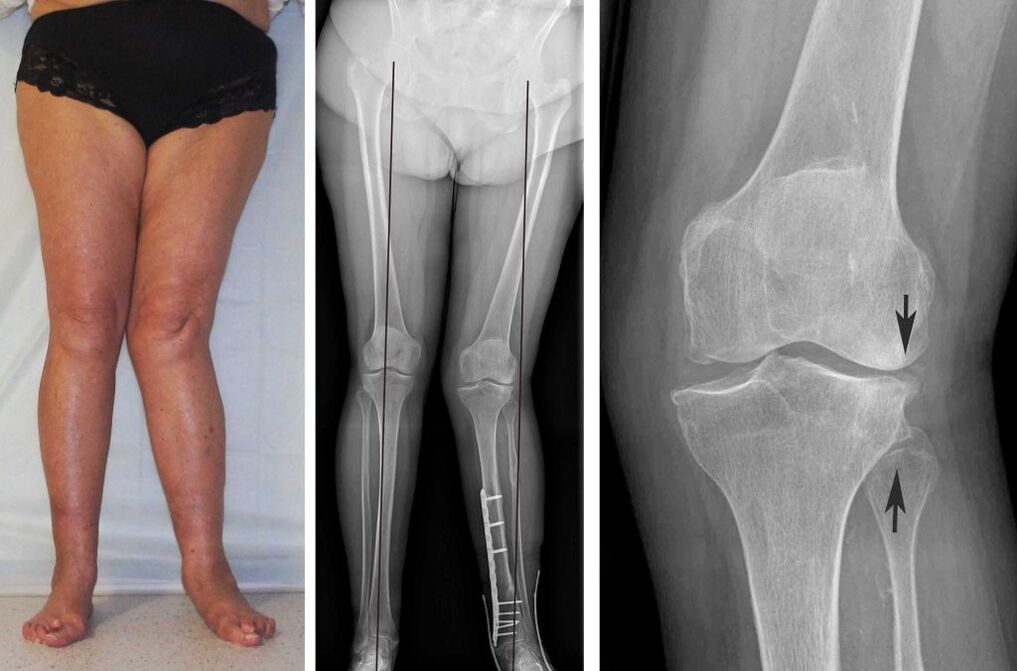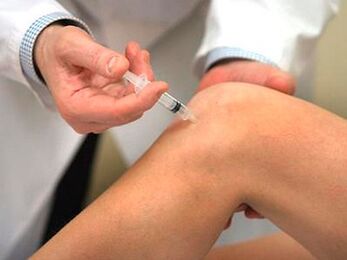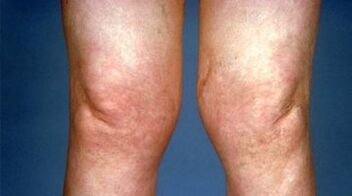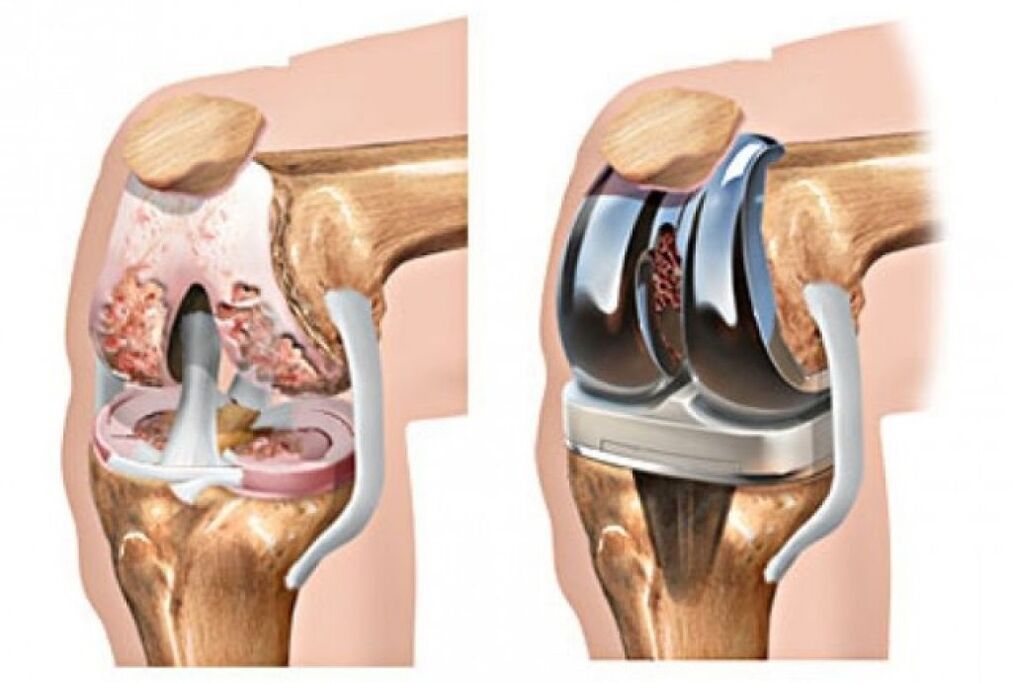Arthropathy of the knee is progressive. As the disease progresses, the cartilage is first damaged, and then the bone elements are involved in the destruction process. High physical activity, lack of physical activity, metabolic disturbances are the causes of the problem.
As the disease progresses, there is a risk of ankylosis, which is accompanied by a reduction in joint motor activity.
Features of the disease

Arthropathy of the knee joint is accompanied by deformation and destruction of cartilage. The pathology is characterized by chronic degeneration and causes varying degrees of pain.
It causes complete loss of motor activity and loss of function. According to ICD-10, the disease is coded as follows: M17. Knee joint disease (knee joint disease).
Pathology affects women more than men. At the same time, people with varicose veins and being overweight have a much higher risk of developing joint disease. That's why the disease is more common in obese women over the age of 40. Older people are also affected. In young adults, arthropathy develops as a result of injuries that occur during physical labor or physical activity.
Arthropathy should be distinguished from arthritis, which is an inflammatory disease caused by a disturbance of the immune system. Infectious diseases can also lead to the development of arthritis.
In the photo, the clinical picture of arthropathy

stage
There are 2 main types of knee arthropathy - primary and secondary. In the first case, the disease appears in childhood and is caused by disrupted development of the surfaces of joints or ligaments.
In this case, the joint is faced with increased loads, leading to degenerative changes. Secondary arthropathy is associated with injuries and other diseases.
Pathology can be unilateral or bilateral. In the first case, the cause of the disease is usually an injury. Bilateral forms of pathology are often the result of obesity.
There are several stages in the development of knee arthropathy. The earlier a disease is detected, the easier it is to deal with.
The main stages of the disease include:
- 1 degree- At this stage, people rarely see a doctor. They felt mild discomfort in the right or left knee after a long walk. Pain syndrome occurs only after increased physical exertion or strong knee flexion and extension. On radiography, a slight narrowing of the joint space and the appearance of bony protrusions in the joint structure can be seen. Pathology was discovered incidentally during other investigations. At this stage, conservative treatment is sufficient.
- 2 degrees- Characterized by more pronounced disease symptoms that are difficult to ignore. Knee pain is often felt. Especially strong in the morning and evening. The discomfort does not go away even in a calm state. A person's gait is slowed, motor activity is disturbed, and the movement of the knee is accompanied by constriction. With a piece of bone or cartilage entering the joint cavity, there is a risk of complications. This causes increased pain and loss of motor activity. On palpation of the knee, there is a risk of severe pain and significant joint deformity. Often an inflammatory process develops. In this case, the knee will swell. On an x-ray, you can see significant narrowing of the joint space, osteophytes, and curvature of the bone. In this case, the patient requires complex treatment. In some cases, it is not possible without surgery.
- 3 degrees- Represents a neglected form of pathology. At this stage, a person develops a permanent disability. The patient had persistent knee pain and impaired motor activities. With any movement, the knee contracts violently. The joint is characterized by marked deformation, increased size due to accumulation of fluid, and almost complete loss of mobility. When radiographs are taken, destruction of the ligaments and meniscus, wear of the cartilage, and an increase in the size of the connective tissue can be seen. Partial fusion of the joint can also be observed. To solve this problem, the affected joints were changed to artificial joints.
In most cases, patients see a doctor in the second stage of arthropathy. This is typical for older adults who are accustomed to age-related changes.
Causes of knee osteoarthritis

The main cause of osteoarthritis is knee injury. Injuries may be due to exercise, arthritis, or other factors.
The main causes of knee osteoarthritis include:
- The predisposing factors of knee joint inflammation can be arthritis, bursitis and other factors.
- Meniscus damage - In the absence of treatment for this pathology, arthropathy often occurs.
- Knee osteochondrosis.
- Physical factors - difficult sports, overweight, etc.
- Fractures, post-traumatic syndrome.
- Meniscal injury surgery, arthroscopy, prolonged block with hormones.
- Pathology that alters knee loading. These include flat feet, lower back lesions, arthropathy. Also included in this category is hip dysplasia.
symptoms and signs
The main manifestations of the disease include:
- Pain - The most common is mechanical discomfort, which can be relieved by pain relievers. It can be dull, painful, and sharp.
- Crunch when moving.
- Impaired joint mobility.
- Decreased physical activity.
- Weakness of the limbs.
- Increased local temperature in the knee area.
- Gait disturbance with leg lameness.
- Violation of stability.
- Knee stuck.
diagnosis

Before starting treatment for arthropathy, it is necessary to conduct a thorough examination.
If you suspect knee disease, you should contact an orthopaedic traumatologist. Experts examine and interview patients to assess the condition of the joints and their range of motion.
To determine the pathology, studies such as:
- Magnetic resonance imaging. With this program, the affected area can be studied by obtaining 3D images. Manipulation showing vasculature and nerve fibers.
- radiography. The program allows you to identify cracks, depressions, bone processes.
What is Dangerous Knee Disease
Consequences of arthropathy include joint inflammation, atrophic changes in muscle tissue and ligaments, and gait disturbance. There is also a risk of lower extremity deformities.
In difficult cases, the disease leads to complete degeneration of cartilage and deformation of bone structure. As a result, the mobility of the limbs decreases and the person becomes disabled.

prevention and prognosis
To avoid developing knee joint disease, you must follow these recommendations:
- Eat well - the menu should contain plenty of vitamins, minerals, protein;
- Get rid of bad habits;
- normalized body weight;
- Participate in sports, walk or cycle, perform medical complexes;
- To avoid injury, protect your legs with knee pads.
The pathology is well suited for treatment, as cartilage tissue thinning is observed only in the third stage. The prognosis is quite favorable.
If treatment is not started on time, there is a risk of disability. Usually this group is assigned to third degree arthropathy. As for military service, they can be exempted from military service as a deformed form of the disease develops.
Knee osteoarthritis is a serious pathology with negative health consequences. To deal with the problem, you need to consult your doctor promptly. Experts will conduct the necessary research and select the appropriate therapy.
























